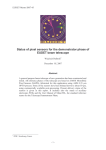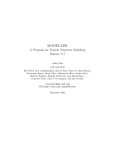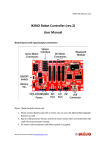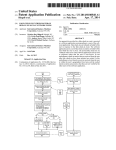Download MimoTEL User Manual - IPHC
Transcript
MimoTEL User Manual C. Colledani, W. Dulinski, H. Himmi, Ch. Hu, I.Valin Institut de Recherches Subatomiques IN2P3-CNRS / ULP Strasbourg – France CENTRE NATIONAL DE LA RECHERCHE SCIENTIFIQUE INSTITUT NATIONAL DE PHYSIQUE NUCLEAIRE P HYSIQUE DES P ARTICULES ET DE MimoTEL Document history Version Date Description 1.0 Based on MimoStar2 Version October 2006 MimoStar chip family Version Date MimoTEL Submitted June 06 3L Submitted June 06 2 Submitted:June 05 1 Submitted July 04 October 2006 Description AMS 035 Opto Version, 256 x 256 pixels, Parallel outputs AMS 035 Opto Version, 640 x 320 pixels, Serial outputs AMS 035 Opto Version, 128 x 128 pixels TSMC 025 Version MimoTEL User Manual MimoTEL 1 2 Introduction ........................................................................................................................ 3 Control Interface ................................................................................................................ 4 2.1 JTAG Instruction Set.................................................................................................. 4 2.2 JTAG Register Set...................................................................................................... 5 2.2.1 Instruction Register ............................................................................................ 5 2.2.2 Bypass Register .................................................................................................. 5 2.2.3 Boundary Scan Register ..................................................................................... 5 2.2.4 ID_CODE Register ............................................................................................ 5 2.2.5 RO_Mode Register0........................................................................................... 5 2.2.6 DIS_COL Register ............................................................................................. 6 2.2.7 BIAS_DAC Register .......................................................................................... 6 3 Running MimoTEL ............................................................................................................ 7 3.1 After reset................................................................................................................... 7 3.2 Biasing MimoTEL...................................................................................................... 7 3.3 Setting the Readout_Mode Register........................................................................... 8 3.4 Readout....................................................................................................................... 8 3.4.1 Signal protocol ................................................................................................... 8 3.4.2 Successive frames and resynchronisation .......................................................... 8 3.5 Analogue Data Format ............................................................................................... 8 3.5.1 Normal mode data format .................................................................................. 8 3.5.1.1 Format of the analogue ouput Asgl<3> ......................................................... 8 3.5.1.2 Format of the analogue ouput Asgl<2> ......................................................... 9 3.5.1.3 Format of the analogue ouput Asgl<1> ......................................................... 9 3.5.1.4 Format of the analogue ouput Asgl<0> ......................................................... 9 3.5.2 Test mode data format........................................................................................ 9 3.6 MimoTEL Chronogram.............................................................................................. 9 3.6.1 Normal Readout ................................................................................................. 9 3.6.1.1 Alternate Mxfirst signal for normal readout ................................................ 11 3.6.2 Test mode readout ............................................................................................ 11 4 Pad Ring ........................................................................................................................... 11 4.1 MimoTEL Pad Ring and Floor Plan View............................................................... 12 4.2 Pad List..................................................................................................................... 13 October 2006 MimoTEL User Manual 2 MimoTEL 1 Introduction MimoTEL, the third version of the MimoStar family, has been designed in C35B4O1, the AMS 0.35 µm opto process. Like MimoStar 1 and 2, it is a Monolithic Active Pixel Sensor prototype dedicated to vertex particle tracking in the EUDET telescope. The matrix is composed by 256 x 256 pixels of 30 µm pitch and based on self biased diode architectures. It is organised in 4 matrices, or subframes, of 256 lines x 64 columns, accessed in parallel during the readout. The individual pixel architecture, should meet the radiation tolerance and the low leakage current requirements. The addressing of each subframe is sequential and starts from the upper left pixel up to the lower right pixel. The beginning of each subframe row is stamped by 2 dummy pixels acting as makers and having programmable levels. Each subframe has its own analogue serial output, a single ended voltage output buffer running up to 20 MHz which gives a readout time of 850µs/frame. Analog Supplies Digital Supplies gnd! Bias Tests vdd! Vdd_diode! vdda! Px<255:255> VREGAMP IPIX IKIMO gnd! Px<255:0> S u b f r a m e S u b f r a m e S u b f r a m e S u b f r a m e 3 2 1 0 ITEST Px<0:255> Px<0:0> Row Address Register <255:0> 4 Colum Address Reg<63:0> Current 2 Refence 1 A M x 1 A M x Bias Generators BIAS DAC Register<87:0> Disable Colum Register <255:0> RoMode <7:0> IDCODE ReadOut Controller CKRDP CKRDN SYNC RSTB TDO TDI TMS TCK Asgl2 Power Supplies CMOS Signals LVDS Signals Analogue Signals Asgl3 JTAG Controller RSTMK SSYNC MXFIRST LASTCOL LASTROW CK20M BSR <9:0> 2 2 1 A M x 1 A M x Asgl0 2 Asgl1 4 A-Mux 64 to 2 MimoTEL functional view Does not correspond to the floorplan; neither for the core, neither for the pad ring October 2006 MimoTEL User Manual 3 MimoTEL MimoTEL is very simple to operate: • Power On Reset or Reset on the RSTB pad • Setup of the chip It is performed with programmable registers accessed via an embedded slow control interface. It consists to: • Load the DACs which bias the analogue blocks • If necessary, load the ReadOut Register with a specific configuration. The default setup on power on reset allows a normal readout once the biases have been set. • Readout of the chip • The readout starts when the input "SYNC" token has its falling signal sampled by the LVDS readout input clock CKRD . It happens at the first rising edge of the 20MHz clock which follows the SYNC falling edge. • After a latency of 4 input clock cycles, the analogue signals appear on the output buffers • Digital maker outputs are available for the control of the readout process • Pixels are sequentially read out in a specific order explained later in the document • Successive pixel frames are read until the readout clock is stopped A frame resynchronisation can be performed at any time by setting up the "SYNC" token again. 2 Control Interface The control interface complies with the Boundary Scan, JTAG, IEEE 1149.1 Rev 1999 standard. It allows the access to the internal registers of the chip like the bias register and the readout mode selection register. On Power-On-Reset, an internal reset for the control interface is generated. The finite state machine of the Test Access Port (TAP) of the controller enters in the Test-Logic-Reset state and the ID register is selected. 2.1 JTAG Instruction Set The Instruction Register of the JTAG controller is loaded with the code of the desired operation to perform or with the code of the desired data register to access. Instruction EXTEST HIGHZ INTEST CLAMP SAMPLE_PRELOAD ID_CODE BIAS_GEN DIS_COL NU1 NU2 NU3 NU4 NU5 NU6 NU7 NU8 NU9 NU10 NU11 NU12 RO_MODE1 RO_MODE0 BYPASS October 2006 5 Bit Code16 01 02 03 04 05 0E 0F 10 11 12 13 14 15 16 17 18 19 1A 1B 1C 1D 1E 1F Selected Register BSR BYPASS BSR BYPASS BSR ID register BIAS register Disable Columns Read Out Mode1 Read Out Mode0 BYPASS Notes JTAG mandatory instruction JTAG optional instruction JTAG optional instruction JTAG optional instruction JTAG mandatory instruction JTAG optional instruction User instruction User instruction Reserved, Not Used Reserved, Not Used Reserved, Not Used Reserved, Not Used Reserved, Not Used Reserved, Not Used Reserved, Not Used Reserved, Not Used Reserved, Not Used Reserved, Not Used Reserved, Not Used Reserved, Not Used User instruction User instruction JTAG mandatory instruction MimoTEL User Manual 4 MimoTEL 2.2 JTAG Register Set JTAG registers are implemented with a Capture/Shift register and an Update register. JTAG standard imposes that the last significant bit of a register is downloaded/shifted first. Register Name INSTRUCTION REG BYPASS BSR ID_CODE BIAS_GEN (11 DACs) DIS_COL RO_MODE1 RO_MODE0 NU1, …, NU12 Size 5 1 9 32 88 256 8 8 0 Access R/W R Only R/W R Only R/W R/W R/W R/W Notes Instruction Register Fixed pattern Previous value shifted out during write Previous value shifted out during write Previous value shifted out during write Previous value shifted out during write Not implemented. For future use 2.2.1 Instruction Register The Instruction register is a part of the Test Access Port Controller defined by the IEEE 1149.1 standard. The Instruction register is 5 bits long. On reset, it is set with the ID_CODE instruction. When it is read the 2 last significant bits are set with the markers specified by the standard, the remaining bits contain the current instruction. X X X 1 0 2.2.2 Bypass Register The Bypass register consists of a single bit scan register. It is selected when its code is loaded in the Instruction register, during some actions on the BSR and when the Instruction register contains an undefined instruction. 2.2.3 Boundary Scan Register The Boundary Scan Register, according with the JTAG instructions, tests and set the IO pads. The BSR is 9 bits long and allows the test of the following input and output pads Bit # 8 7 6 5 4 3 2 1 0 Corresponding Pad LVDS CkRdP/CkRdN ASync SSync Ck5M Ck20M RstMk LastRow LastCol MxFirst Type Input Input Output Output Output Output Output Output Output Signal CkRd Sync SSync Ck5M Ck20M RstMk LastRow LastCol MxFirst Notes Resulting CMOS signal after LVDS Receiver Internal only, Not used 2.2.4 ID_CODE Register The Device Identification register is implemented is this third version. It is 32 bits long and has fixed value hardwired into the chip. When selected by the ID_CODE instruction or after the fixed value is shifted via TDO, the JTAG serial output of the chip. ID_CODE register value is 0xFFFF8001 2.2.5 RO_Mode Register0 The RO_Mode registers are 8 bits large; they allow the user to select specific features of the chip. MimoTEL use only the RO_Mode Register0. October 2006 MimoTEL User Manual 5 MimoTEL Bit # Bit Name 7 Not Used 6 Not Used 5 DisLVDS 4 SelMux 3 EnaGain3 2 1 0 Not used Not Used EnaTstCol Purpose Default value Disable LVDS, readout clock is not active 0 LVDS selected anymore. On MxFirst output pad, select the MuxFirst 1 MuxFirst Signal, active signal or the First_Pixel_of the Frame signal See § 3.4 Readout Select gain 3 for the serial differential output 0 Gain 5 buffer Test Mode: Select the 2 Test Levels, IVTEST1 0 Normal mode and IVTEST0, which emulate a pixel output 2.2.6 DIS_COL Register The DIS_COL register is 256 bit wide. The purpose of this register is to disable the column current sources if a short circuit is suspected on a specific column. During the readout, even if a current source is disabled the corresponding column is selected, i.e. no columns are skipped. Obviously, the signal of the corresponding pixel has no signification. The default value of the DIS_COL register is 0; it means that all current sources can be activated by the readout logic. Setting a bit to 1 disables the corresponding current source. The column <256> is on the left hand side while column<0> is on the right hand side. The organisation of the chip in 4 subframes of 64 columns has no matter to do with the DIS_COL register. 255 (Msb) DisCol<255> 0 (Lsb) DisCol<0> 2.2.7 BIAS_DAC Register The BIAS_DAC register is 88 bits large; it sets simultaneously the 11 DAC registers. As show bellow these 8-bit DACs set voltage and current biases. After reset, the register is set to 0, a value which fixes the minimum power consumption of the circuit. The current values of the DACs are read while the new values are downloaded during the access to the register. The image of the value of some critical biases can be measured on corresponding test pads. Bit range 87- 80 79- 72 DAC # DAC10 DAC9 71- 64 DAC8 63- 56 55- 48 DAC7 DAC6 47- 40 39- 32 31- 24 23- 16 DAC5 DAC4 DAC3 DAC2 15- 8 DAC1 7- 0 DAC0 October 2006 DAC Internal DAC purpose Name IKIMO External circuit monitoring I4PIX Pixel source follower bias. DAC with positive slope (0 to 255 µA; 1 µA step) V4TEST1 Test Level, emulates a pixel output. DAC with positive slope (0 to 2.55V; 10 mV step) V4TEST0 Idem V4REG3 Regulator voltage bias for the column amplifier (Gain 3 &5). DAC with negative slope ((3.3 to 0.75 V by step of 10 mV) V4REG2 Idem V4REG1 Idem V4REG0 Idem I4REGAMP Regulator current bias for column amplifier (G = 3 & 5) This DAC value is not very sensitive for test. DAC with positive slope (0 to 255 µA; 1 µA step) I4AMP Bias of column amplifier. DAC with positive slope (0 to 255 µA; 1 µA step) ISLOWBUFSE Bias of the single ended Output Buffers. DAC with positive slope (0 to 255 µA; 1 µA step) MimoTEL User Manual Corresponding Test Pad IKIMO IPIX No pad No pad VREGAMP No pad No pad No pad No pad No pad No pad 6 MimoTEL 3 Running MimoTEL The following steps describe how to operate the ASIC. 3.1 After reset On RSTB active low signal: • All BIAS registers are set to the default value, i.e. 0 • DIS_COL is set to 0, i.e. all columns are selected • RO_Mode is set to 0 • JTAG state machine is in the Test-Logic-Reset state • JTAG ID_CODE instruction is selected Then the bias register has to be loaded. The same has to be done for the RO_MODE0 and DIS_COL registers if the running conditions differ from defaults. Finally the readout can be performed either in normal mode or in test mode. 3.2 Biasing MimoTEL The BIAS_DAC register has to be loaded before operating the chip. The 11 DACs constituting this register are built with the same 8 bits DAC current generator which has a 1 µA resolution. Specific interfaces like current mirror for current sourcing or sinking and resistors for voltages, customise each bias output. The following table shows the downloaded codes which set the nominal bias. Internal DAC Name Resol Range Simulation Experimental(1) Code16 –Code10 Code16 - DacInterna Output ution Code10 l current- value µA IKIMO 64-100 100 1V 10 mV From 0 up to 2.55 V 0-0 I4PIX 1E-30 30 30 µA 1 µA From 0 up to 255 µA 1-1 V4TEST1 C3–195 195 1.95 V 10 mV From 0 up to 2.55 V FA-250 V4TEST0 B9–185 185 1.85 V 10 mV From 0 up to 2.55 V E6-230 V4REG 3 23–35 35 2.95 V 10 mV From 3.3 down to 0.75 V 80-128 V4REG 2 23–35 35 2.95 V 10 mV From 3.3 down to 0.75 V 80-128 V4REG 1 23–35 35 2.95 V 10 mV From 3.3 down to 0.75 V 80-128 V4REG 0 23–35 35 2.95 V 10 mV From 3.3 down to 0.75 V 80-128 I4REG1 21–33 33 33 µA 1 µA From 0 up to 255 µA 1-1 I4AMP 64–100 100 100 µA 1 µA From 0 up to 255 µA 3-3 ISLOWBUFSE 64–100 100 100 µA 1 µA From 0 up to 255 µA A-10 Note 1: The HRES ploysilicon, used in the bias block, is missing for this submission. Experimental values correspond to the recalculated parameters that allow nevertheless the chip be operated. A new submission of the chip is in progress. Bias synthetic block diagram Vrefn G=3&5 V Regulator I4PIX ISLOWBUFSE V4REGn + - I4REGAMP I4AMP * n = 0, 1, 2, 3 for 4 sub-matrices V4TEST1 + - October 2006 + - V4TEST0 MimoTEL User Manual 7 MimoTEL Note1: Vrefn ~= V4REGn – 1V 3.3 Setting the Readout_Mode Register If the desired operating mode does not correspond to the default one, set the Readout_Mode0 register following the §2.2.5 information. 3.4 Readout 3.4.1 Signal protocol Ones JTAG registers have been loaded, the readout of MimoTEL may initiate with the following signal protocol: • The readout clock CKRD is started. This allows the output pad CK20M to generate a 20 MHz clock. This clock follows the input. • The SYNC signal is set. • The readout starts at the first rising edge of CKRD after SYNC signal disappears. • Signal markers allow the monitoring of the readout and the analogue data sampling: o RstMk maker confirms that the internal reset of the readout logic is done. o SSync marker shows that the readout starts. o 4 extra CKRD clock cycles, after SYNC sampling, are necessary before the analogue signal of the first pixel appears on the output pad. o The MxFirst digital signal helps for a better sampling of the analogue output signals. The way it acts is set by the RO_Mode[4] bit. RO_Mode[4] = 0: MxFirst is active during the duration of the first maker of the frame RO_Mode[4] = 1: MxFirst is active on each pixel change on the analogue output i.e. it is a 20 MHz periodic signal. o LastCol is active when the last column of the current row is selected o LastRow is active when the last row of the frame is selected o Ck20M output shows the internal clock running as long as input clock is running. 3.4.2 Successive frames and resynchronisation Successive pixel frames are read until the readout clock is stopped. A frame resynchronisation can be performed at any time by setting up the "SYNC" token again. 3.5 Analogue Data Format Two types of signal can be generated • Normal pixel signal • Test signal. 3.5.1 Normal mode data format In order to improve the readout speed MimoTEL is organized 4 subframes. Each subframe has its own analogue serial output, a single ended voltage output buffer running up to 20 MHz. During the readout, the 4 subframes are accessed in parallel. For each subframe the addressing is done row by row, each pixel is accessed sequentially from the left side to right side. Each row contains 2 makers (acting as dummy pixels), and 64 active pixels. One can use the adjustable level of the 2 makers as a pattern recogniser. If the pixel coordinate format is specified as Px<Line, Column>, then for each subframe, the upper left pixel is Px<255, 63> while the lower right is Px<0, 0> and the makers of each beginning row are named Mk1 and Mk0. Thus the 4 parallel outputs generate respectively the following stream formats: 3.5.1.1 Format of the analogue ouput Asgl<3> Mk1, Mk0, Px<255,255>, Px<255,254>,. . ., Mk1, Mk0, Px<254,255>,.Px<254,254>,. . ., . . . . . . . . . . . . . . . . . . . . . Mk1, Mk0, Px< 1,255>,.Px< 1,254>,. . ., Mk1, Mk0, Px< 0,255>,.Px< 0,254>,. . ., October 2006 Px<255,192> Px<254,192> . . . . . . Px< 1,192> Px< 0,192> MimoTEL User Manual 8 MimoTEL 3.5.1.2 Format of the analogue ouput Asgl<2> Mk1, Mk0, Px<255,191>, Px<255,190>,. . ., Mk1, Mk0, Px<254,191>,.Px<254,190>,. . ., . . . . . . . . . . . . . . . . . . . . . Mk1, Mk0, Px< 1,191>,.Px< 1,191>,. . ., Mk1, Mk0, Px< 0,191>,.Px< 0,191>,. . ., Px<255,128> Px<254,128> . . . . . . Px< 1,128> Px< 0,128> 3.5.1.3 Format of the analogue ouput Asgl<1> Mk1, Mk0, Px<255,127>, Px<255,126>,. . ., Mk1, Mk0, Px<254,127>,.Px<254,126>,. . ., . . . . . . . . . . . . . . . . . . . . . Mk1, Mk0, Px< 1,127>,.Px< 1,126>,. . ., Mk1, Mk0, Px< 0,127>,.Px< 0,126>,. . ., Px<255, Px<254, . . . . Px< 1, Px< 0, 3.5.1.4 Format of the analogue ouput Asgl<0> Mk1, Mk0, Px<255, 63>, Px<255, 62>,. . ., Mk1, Mk0, Px<254, 63>,.Px<254, 62>,. . ., . . . . . . . . . . . . . . . . . . . . . Mk1, Mk0, Px< 1, 63>,.Px< 1, 62>,. . ., Mk1, Mk0, Px< 0, 63>,.Px< 0, 62>,. . ., Px<255, 0> Px<254, 0> . . . . . . Px< 1, 0> Px< 0, 0> 64> 64> . . 64> 64> 3.5.2 Test mode data format During the test mode the pixel matrix is not anymore connected to the multiplexing electronic. In place of it, two test levels V4TEST1 (V1), V4TEST0 (V0) are available. They emulate two pixel level outputs. Actually these levels correspond to those of Marker 1 and Marker 0. They are adjustable via 2 DACs. Even and odd columns are alternatively connected to one of them. This pattern allows seeing the output signal changing and emulates the readout shift from one column of pixel to the other column of pixel. Thus the 4 parallel outputs generate respectively the following stream formats: Subframe 3, analogue ouput Asgl<3>: Subframe 2, analogue ouput Asgl<2>: Subframe 1, analogue ouput Asgl<1>: Subframe 0, analogue ouput Asgl<0>: 3.6 V1, V0, V1, V0, V0, V1, V0, V1, V0, V1, V0, V1, V1, V0, V1, V0, V1, V0, V1, V0, V0, V1, V0, V1, V0, V1, V0, V1, V1 V0 V1 V0 . . . . . . . . . . . . MimoTEL Chronogram The following chronograms describe typical access to the chip; Reset, JTAG download sequence and then the readout. This one starts with the initialisation phase followed by the successive row readouts as showed in the zoom. 3.6.1 Normal Readout Figure 1 show the beginning of a typical normal data readout mode. After Reset and JTAG settings, one can see the initialisation phase of the readout of the first pixel row. The LastCol signal is active meanwhile the last pixel of a row is read. The last row of the frame makes the LastRow signal to be active. One of the 4 parallel analogue outputs is showed. One can distinguish the 2 makers placed at the beginning of each row. Figure 2 is the zoom of the readout of the first row. Figure 3 is an enlargement of the transition from one row to the successive one. Figure 4 show the alternate option of the MxFirst signal. It is active only during the time the first maker appears i.e. just before the first pixel of the frame. This option is set via the RoMode register. October 2006 MimoTEL User Manual 9 MimoTEL Reset Jtag access Idle 1 rstrow readout + Init Successive row readouts Last row readout Figure 1 <3> Marker<0> Px<255,248> Px<255,254> Px<255,255> Px<255,253> Px<255,249> Px<255,247> Marker<1> 1 rst row readout phase Initialisation phase Figure 2 <3> Marker<0> Px<255,191> Px<255,192> Px<255,190> Px<255,254> Px<254,255> Px<255,253> Marker<1> End of 1 rst row readout 2 nd row readout Figure 3 October 2006 MimoTEL User Manual 10 MimoTEL 3.6.1.1 Alternate Mxfirst signal for normal readout Figure 4 3.6.2 Test mode readout The initialisation phase if the test mode is the same than in the normal mode. But it has to be noticed than the LastCol and LastRow makers are unavailable because the test mode has nothing to deal with the matrix and its line and column addressing registers. For the same reason the MxFirst maker is unavailable in the “First Pixel of frame mode” but only continuous mode. V0 V1 V0 V0 V1 V1 V1 V1 V0 V0 V0 V0 V1 V1 V1 V1 4 Pad Ring The pad ring of the chip is build with • Pads full custom designed for some of the analogue signals and power supplies • Pads from the AMS library for the digital signals and power supplies The pad ring is split in 6 functional independent parts. Each part has its own supply pads. October 2006 MimoTEL User Manual 11 MimoTEL 4.1 MimoTEL Pad Ring and Floor Plan View SubMx3 SubMx1 SubMx2 SubMx0 RdO-Cntl 20 DAC 1 P_A1 P_D1 P_A2 P_L P_D2 P_A3 75 Foundry submission information MimoTEL has been designed in AMS C35B4O1 CMOS 0.35 μm. The Process Design Kit V3.70 has been provided by CMP CAD tools are CADENCE DFII 5.0 with DIVA and ASSURA rules October 2006 MimoTEL User Manual 12 MimoTEL 4.2 Pad List Pad 1 2 3 4 5 6 7 8 9 10 11 12 13 Name IKIMO IPIX VREGAMP gnd Aout<3> gnd gnd gnd gnd ITEST vdda vdda vdda Pad ring segment 1 – P_A1 Pad General Function PadType APRIOP Analog I/O pad, 0 Ω serial APRIOP Analog I/O pad, 0 Ω serial APRIOP Analog I/O pad, 0 Ω serial Core logic and periphery cells supply AGNDALLP Direct Pad, no protections DIRECTPAD Core logic and periphery cells supply AGNDALLP Core logic and periphery cells supply AGNDALLP Core logic and periphery cells supply AGNDALLP Core logic and periphery cells supply AGNDALLP APRIOP Analog I/O pad, 0 Ω serial Analogue Pad Supply AVDDALLP Analogue Pad Supply AVDDALLP Analogue Pad Supply AVDDALLP Pad 14 15 16 17 18 19 20 21 22 23 24 25 26 27 28 29 30 Name RSTMK vddd vddd LastRow vddd LastCol vddd vddd CK20M gnd gnd MxFirst gnd Ssync gnd gnd Sync Pad ring segment – P_D1 Pad General Function PadType Tri-State Output Buffer, 2 mA BT2P Core logic and periphery cells supply VDD3RP Core logic and periphery cells supply VDD3RP Tri-State Output Buffer, 2 mA BT2P Core logic and periphery cells supply VDD3RP Tri-State Output Buffer, 2 mA BT2P Pad supplying the output buffers VDD3OP Pad supplying the output buffers VDD3OP Tri-State Output Buffer, 2 mA BT2P Pad supplying the output buffers GND3OP Pad supplying the output buffers GND3OP Tri-State Output Buffer, 2 mA BT2P Core logic and periphery cells supply GND3RP Tri-State Output Buffer, 2 mA BT2P Core logic and periphery cells supply GND3RP Core logic and periphery cells supply GND3RP CMOS Input Buffer ICP Function for the chip Readout Reset Marker 3.3 V 3.3 V Last Row Maker 3.3 V Last Column Marker 3.3 V 3.3 V 20 MHz Clock Out Ground Ground First pixel maker Ground periphery cells only Readout Synchro. Start Marker Ground periphery cells only Ground periphery cells only Readout Input token Name gnd gnd Aout<2> gnd vdda vdda vdd_diode vdd_diode vdd_diode vdda vdda gnd Aout<1> Pad ring segment – P_A2 Pad General Function PadType Core logic and periphery cells supply AGNDALLP Core logic and periphery cells supply AGNDALLP Direct Pad, no protections DIRECTPAD Core logic and periphery cells supply AGNDALLP Analogue Pad Supply AVDDALLP Analogue Pad Supply AVDDALLP Direct pad, no protections DIRECTPAD Direct pad, no protections DIRECTPAD Direct pad, no protections DIRECTPAD Analogue Pad Supply AVDDALLP Analogue Pad Supply AVDDALLP Core logic and periphery cells supply AGNDALLP Direct Pad, no protections DIRECTPAD Function for the chip Ground periphery & core Ground periphery & core Analogue data out Ground periphery & core 3.3 V 3.3 V Pixel Diode Bias, 3.3V Pixel Diode Bias, 3.3V Pixel Diode Bias, 3.3V 3.3 V 3.3 V Ground periphery & core Analogue data out Pad 31 32 33 34 35 36 37 38 39 40 41 42 43 October 2006 MimoTEL User Manual Function for the chip Gen Purpose DAC Output DAC Out, Test Purpose Only DAC Out, Test Purpose Only Ground periphery & core Analogue data out Ground periphery & core Ground periphery & core Ground periphery & core Ground periphery & core Internal Current Ref Source 3.3 V 3.3 V 3.3 V 13 MimoTEL 44 gnd 45 gnd Core logic and periphery cells supply Core logic and periphery cells supply AGNDALLP AGNDALLP Ground periphery & core Ground periphery & core Name gnd CKRN CKRP vdd Pad ring segment 3 – P_L Pad General Function PadType Function for the chip LVDS Pad Ground AGNDALLP Ground for LVDS Pad Full Custom Readout Clock Signal LVDS In LVDS In + LVDS Pad Supply AVDDALLP 3.3V for LVDS Pad Pad 50 51 52 53 54 55 56 57 58 59 60 61 62 63 64 65 66 Name vddd vddd RSTB vddd vddd TMS vddd vddd TDI gnd gnd TCK gnd gnd TDO gnd gnd Pad ring segment 2 – P_D2 Pad General Function PadType Core logic and periphery cells supply VDD3RP Core logic and periphery cells supply VDD3RP Schmitt-Trigger Input Buffer, Pull Up ISUP Core logic and periphery cells supply VDD3RP Core logic and periphery cells supply VDD3RP CMOS Input Buffer, Pull Up ICUP Pad supplying the output buffers VDD3OP Pad supplying the output buffers VDD3OP CMOS Input Buffer, Pull Up ICUP Pad supplying the output buffers GND3OP Pad supplying the output buffers GND3OP CMOS Clock Input Buffer, 2 mA ICCK2P Core logic and periphery cells supply GND3RP Core logic and periphery cells supply GND3RP Tri-State Output Buffer, 4 mA BT4P Core logic and periphery cells supply GND3RP Core logic and periphery cells supply GND3RP Function for the chip 3.3 V 3.3 V Asynchronous Active Low Reset 3.3 V 3.3 V JTAG Control Signal 3.3 V 3.3 V JTAG Control Signal Ground Ground JTAG Clock Ground Ground JTAG Serial Data Out Ground Ground Pad 67 68 69 70 71 72 73 74 75 Name vdda vdda vdda gnd Aout<0> gnd gnd gnd gnd Pad ring segment – P_A3 Pad General Function PadType Analogue Pad Supply AVDDALLP Analogue Pad Supply AVDDALLP Analogue Pad Supply AVDDALLP Core logic and periphery cells supply AGNDALLP Direct Pad, no protections DIRECTPAD Core logic and periphery cells supply AGNDALLP Core logic and periphery cells supply AGNDALLP Core logic and periphery cells supply AGNDALLP Core logic and periphery cells supply AGNDALLP Function for the chip 3.3 V 3.3 V 3.3 V Ground Analogue data out Ground Ground Ground Ground Pad 46 47 48 49 October 2006 MimoTEL User Manual 14
























